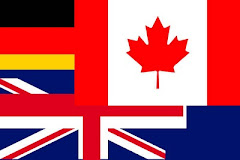Do you use timelines in your genealogical research? I do.
On Tuesday, October 26 (that is tomorrow), I will be speaking at the Bruce County Museum in Southampton, Ontario at 7:30 p.m. to the Bruce Grey Branch of the Ontario Genealogical Society and their guests the Bruce County Genealogical Society. My topic is Timelines and Genealogy. The public is welcome to attend and there is no charge.
The talk is illustrated with examples of timelines. The four areas I will focus on are 1) what are timelines and different types of timelines 2) using timelines during the genealogical research phase and 3) using timelines as you develop the story of the people and 4) using timelines as a visual presentation of a person or family's life.
Has the use of timelines helped you in your genealogical research? If you wish to share an example please comment.
© 2010 Janet Iles
Subscribe to:
Post Comments (Atom)





Recently, I completed my first timeline as a way to try to get through a brickwall. I thought the timeline would show me where gaps in my research are and help develop next steps in my research. I haven't broken through yet, but it did help me organize my research.
ReplyDeleteIn an effort to keep me from getting sidetracked (which any researcher knows is bound to happen from time to time), I try to work in depth on one ancestor at a time. With that in mind, I keep a whiteboard on the wall within view of my desk at home, upon which I keep an "active" timeline of the person I'm researching and I will jump up and add to it when I discover a new fact. This serves two purposes: (1) I can see the important dates without having to switch back and forth to my genealogy program, and (2) it sort of helps me not get too sidetracked ... sort of. :)
ReplyDeleteThanks Brenda and Jenny for your comments. Brenda, I hope the timeline helps solve your brick wall or it gives you some ideas of other places to look.
ReplyDeleteJenny, if you don't mind, I would like to mention your idea of the white board in my talk.
If anyone else has anything to share about timelines, I hope you can take the time to post a comment.
I use timelines as a basic spine when writing biographies. The first one I made (see: http://tracingmytreeroots.blogspot.com/2010/02/timeline-henriette-geertruida-lamboo.html) was actually for a carnival-post where I wrote my grandmother's biography, in as far as I had the data back then.
ReplyDeleteIt's my dream to write a biography for every ancestor I research when I deem that ancestor 'finished', as I have found out that I do best when just researching one or two people at a time. Currently I am working on the biography of Lodewijk Wesselo and I started by making a timeline of all events in his life by printing the fact-list from my genealogy program for him and then adding some events like the births of his children. Then I highlighted the events I wanted to include in my biography and that formed the basis for my writing. So that's how I use my timelines.
Janet ... nice to see you "Introduced" on today's GeneaBloggers message! As for timelines, I find them absolutely essential for working on and analyzing problems.
ReplyDeleteWish I could zip up to Ontario from Colorado for your presentation! Timelines have been essential in researching my cattle rustler's story and writing a book about it. It was a timeline that helped me realize he'd been arrested twice and spent two years in prison instead of the reported ten. I couldn't figure out how he had two children while he was in prison! Timelines help me know what to research and look into next.
ReplyDeleteI love the whiteboard idea, too.
Thanks, J.M., Brenda and Gayle for your comments. At the talk, one person shared that she uses cards with information on them and she moves the cards around as she creates a timeline before committing it to a computer.
ReplyDeleteI can see this being very helpful if you are working on a visual presentation of events and their sequence.